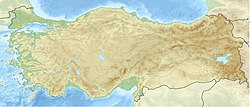Top Qs
Timeline
Chat
Perspective
Körtik Tepe
Neolithic site in Turkey From Wikipedia, the free encyclopedia
Remove ads
Körtiktepe or Körtik Tepe is the oldest known Neolithic archaeological site in Turkey, occupied from 10,700 BCE (C14 cal. 10,687 BCE ± 78 years) at the end of the Epipaleolithic,[2][3] throughout much of the Younger Dryas, and during the early Pre-Pottery Neolithic A, for a period of more than a millennium until circa 9,250 BCE, when it was abandoned.[4][2] Together with Tell Abu Hureyra and Tell Mureybet in northern Syria, Körtik Tepe is one of the only three securely dated sedentary sites in Upper Mesopotamia during the droughts and cold period of the Younger Dryas, and one of the earliest known settled site by hunter-gatherers, complete with trade, art, food production, religious ritual and social complexity.[5][6][7]
The site was fully excavated from 2000 to 2018, in the context of salvage operations before flooding by the Ilısu Dam.[2] The ruins were backfilled before the flooding, but the analysis of recovered items continues to this day.[2]
Remove ads
Settlement
Summarize
Perspective
The habitation of the site began in the first half of the 11th millennium BCE, approximately 10,700 BCE (12,700 years ago), and occupation became continuous with consistent density from at least 10,400 BCE.[2] Permanent occupation was ascertained throughout much of the Younger Dryas (10,900-9,700 BCE), and during the early Pre-Pottery Neolithic A.[2] The rich ecological environment around Kortik Tepe, with abundant year-round resources, especially mammals, plants and fish, probably explains the attractiveness of staying in the same place, with sedentary permanent habitation.[8] The inhabitants were exceptionally tall (1.72m for males, 1.63m for female in average), and healthy.[9] No traces of violence were observed at the site.[10]


Within the context of Pre-Pottery Neolithic sites across West Asia, Körtiktepe is the most populated site yet known, with over 2000 single and double burials, and 460 architectural remains.[2] Burials often involved defleshing and coloring the skeleton of the deceased with black and red paint.[12] Numerous ritual items have also been found, whose designs have been influential throughout Upper Mesopotamia.[2]
Several circular buildings were found at the site, constructed with relatively thin stone walls, from at least 10,400 BC and until the abandonment of the site.[4][2] It is thought by the discoverers that these formed a circular stone basis, on top of which a tent-like structure was erected for the roofing, made of poles supporting a lattice, with a covering of plaster and mud.[13] The construction in group evokes permanent rather than temporary settlement.[4] Several tombs were also found under the floors, with some differentiation in the quality and quantity of graves goods, suggesting social stratification.[4] Occupation continued and thrived during the Early Holocene. The architectural tradition of constructing round plans established around 10400 BCE and continued without any fundamental alterations until the eventual desertion of the site.[14]
Remove ads
Characteristics
Summarize
Perspective
The people of Körtik Tepe were entirely hunter-gatherers, without agriculture, but, contrary to their predecessors had a highly intensive manufacturing activity.[2] Hundreds of thousands of flint and obsidian tools were discovered at the site, as well as 500 stone vessels, many of them decorated with incised designs of plants, animals and symbol.[2] Thousands of stone and shell beads were also discovered, 2000 bone tools, as well as hundreds of ground stone tools and scepters, and hundreds of decorated bone and stone plaques.[2]

Strontium and oxygen isotope analyses of human tooth enamel indicate that the inhabitants of the Younger Dryas occupations at Körtiktepe were born and grew up in or near the site, which is another indicator of sedentarism.[2] Although a potential minor flooding event transpired during the transition from the Younger Dryas to the Early Holocene, the site endured without evident abandonment, at least not for a prolonged interval. Occupation continued and thrived during the Early Holocene.[15]
The site reached its peak in terms of occupation density around 9300 BCE.[16] Subsequently, it experienced an unexplained abandonment circa 9250 BCE, possibly attributed to natural disturbances such as flooding induced by the warming of the Holocene climate changes.
Remove ads
Art
Summarize
Perspective
Körtik Tepe is recognized for the outstanding quality and richness of its visual arts, as seen on stone vessels and stone ritual objects, including depictions of humans, animals and various symbols, particularly undulating snakes.[17] The production of decorative symbolic items, including decorated bone palettes, started during the Younger Dryas period, from the 11th millennium BC.[2] The early Holocene saw the development of human, animal or hybrid imagery.[2] Many of the motifs and symbols of Körtik Tepe in the Mesopotamian Basin, including at the subsequent Taş Tepeler culture sites such as Gobekli Tepe.[2] Similar items only started to appear at other Pre-Pottery Neolithic sites towards the end of the occupation period of Körtik Tepe, as in Gusir Höyük or Hasankeyf Höyük.[2]
Chronologically, Kortik Tepe is followed by the Taş Tepeler culture sites of Karahan Tepe (ca. 9750 BCE) and Göbekli Tepe (ca. 9600–8200 BCE), characterized by important monumental developments, and Jericho (site of Tell es-Sultan) (ca. 9600–8500 BCE) with its wall structure around an early city.
Körtik Tepe may have been a predecessor of the PPN artistic and material culture in Upper Mesopotamia, including Göbekli Tepe and the other Taş Tepeler sites.[18]
- Decorated stone ritual objects, Körtik Tepe, 10,400-9250 BCE, Diyarbakır Archaeology Museum.[4]
- Incised bone pendant fragments
- Stone vessel with gazelle motif
- Stone vessel with undulating snake symbols
- Decorated stone ritual objects with dog motif, Kortik Tepe, 10,400-9250 BCE, Diyarbakır Archaeology Museum.[19]
- Burial gifts of a sub-floor burial from a round building of Körtik Tepe
- Goat Palette, KTK07, Early Holocene 9350 cal BCE, Körtik Tepe.[20]
Notes
Bibliography
See also
Wikiwand - on
Seamless Wikipedia browsing. On steroids.
Remove ads










